Artists, political protesters, and groups organizing alternative institutions have, since at least the days of the early 20th Century Avant-Garde, converged and then fragmented again, moving towards and away from each other in an elaborate historical dance that sometimes resembles a waltz and still other times a boxing match. Lately they find themselves on increasingly common ground as their mutual interest to move away from spectatorship and into engagement finds form in direct social actions. The “Social Choreography” research group is interested in exploring the proliferation of artistic projects that cross the lines of activism, protest, community organizing, and alternative institutions building, on both the Left and the Right, to make use of cultural forms in order to express their views. The most noteworthy of these projects have an effect on society while existing simultaneously in the symbolic plane of art. By producing public programming, this research group will reflect the theme of “social choreography” in form as well as content, resulting in programs that go beyond spectatorship and lead out into the dance of everyday life, movement and politics.
CHOOSE A PATHWAY
Paul Ramirez Jonas Gregory Sholette Working Group
This page is an amalgam of all of the events associated with Social Choreography. If you would like to track the work of either of our faculty co-leaders or the working group, click on the names above, or look for events with the same color font as the name.
EVENTS
 In Solidarity Round-Table, Monday, March 7th 2016, 12:00-4:00pm, The James Gallery
In Solidarity Round-Table, Monday, March 7th 2016, 12:00-4:00pm, The James Gallery
In Solidarity is a round-table dedicated to the intersecting issues, struggles, resistance strategies and political imaginations between the Black Lives Matter and Palestinian Liberation movements. The round-table is conceived as a preliminary effort to reflect on a history of solidarity work between the Black Power movement and Palestinian struggles and to build on present-day mobilizing that has surged since the of summer 2014, following the protest in Ferguson, Missouri in the aftermath of Mike Brown’s killing and in Palestine, following the war on Gaza. Solidarity work is currently propagating and is evident in the video titled ‘When I See Them I see Us’ released in 2015 by Black Solidarity with Palestine, featuring Black and Palestinian artists and activists, and as well as recent academic divestment and International Wave of Action in Solidarity with Palestine efforts. In Solidarity aims to create activist-oriented artistic interventions and to facilitate a platform to reflect, analyze and expand our collective political imagination around resistance, organizing and visions vis-à-vis increased state violence, ongoing occupation and militarization of everyday life. The round-table is meant to be as broadly interdisciplinary as possible – bridging activist and social justice organizing experiences with social science and policy perspectives as well as literature, humanities and creative arts. A post-workshop publication with a selection of papers is a possible outcome. Read more…
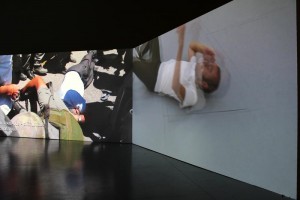 Sovereign Selves? Choreography and Human Rights in the Archive, Friday, February 19, 2016, 6:30pm – 8:30pm, Martin E. Segal Theatre
Sovereign Selves? Choreography and Human Rights in the Archive, Friday, February 19, 2016, 6:30pm – 8:30pm, Martin E. Segal Theatre
This panel discussion between a choreographer, Arkadi Zaides, dramaturg and performance scholar, Eda Cufer, psychoanalyst, Aleksandra Wagner, Middle East scholar, Deen Sharp, and curator, Katherine Carl will explore bodily gesture and the questions of self-sovereignty in the spatial and temporal territory of the archive. If violence is latent in every body, how are meanings of violence translated through everyday gestures and how is this shaped by the contexts of territory, history, and culture? In the exhibition on view in the James Gallery, how does Arkadi Zaides’ re-performance of gestures from footage from human right archives focus attention on gestural language of violence and particularly its impact on the perpetrator? How does over-identification with a dominant structure through performance open productive critical perspectives? What is the common ground of visual representations and embodied practices like dance in the practice of archiving? Read more…
PAST EVENTS
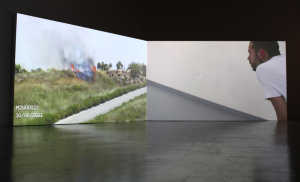
Capture Practice: Arkadi Zaides Opening Reception, February 4th, 6:00 – 8:00pm, The James Gallery
The James Gallery presents internationally-acclaimed choreographer Arkadi Zaides’ first solo exhibition in New York. Zaides and his collaborators explore gestures of everyday life through the use of documentary footage. The artworks focus on the Israeli-Palestine conflict to reveal different discourses of human rights. The exhibition includes the two-channel video installation Capture Practice (2014) made with Effi Weiss & Amir Borenstein; the world-premiere of The Protest (2016) made in collaboration with documentary filmmaker Dana Shalev; and the multidisciplinary artist Daniel Landau’s 360 video Time-Motion Study (2016). Arkadi Zaides performed Archive on February 9 and 10 at 7:30pm as part of New York Live Arts’ Live Ideas Festival: MENA/Future. Read more…
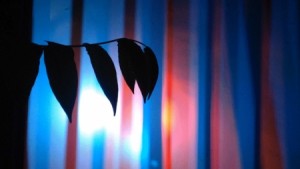
Time Farm, Lou Cantor and Alexandra Pirici, December 10th, 6:30pm, The James Gallery
Time Farm (Abraham Adams, Lou Cantor, and Alexandra Pirici) is a research group dedicated to cultivating temporal inquiry. This performance will be a platform to deepen the group’s interest in the nuances, difficulties, and wonders of human communication through language. With techniques that look beyond historiographic time out of joint, Time Farm’s parapoetics seek out temporal dogmas in the conduct of meaning: Husserl’s inscription of discursive sequence at the basis of experience; the fantasy eternal theorized by Félix Guattari; fears of transtemporalism observed by Rita Felski. Abraham Adams will present the short lecture “Concrete Séance,” a third installment of his series, which the Poetry Foundation reports to be a “return to sortilèges.” Lou Cantor’s presentation will sketch a map of the main trajectories their work follows in relation to the changing context and ever-developing audience perception. Their lecture performance “We are not Asleep” pays tribute to the work of Krzysztof Niemczyk and aims to form questions that answer the contemporary reality of overproduction in under time. Alexandra Pirici will give a short overview of her artistic practice in relation to general topics of interest such as time and temporality, embodied and disembodied media, the materiality of the enactment or embodiment as strategy, the second performative turn in the visual arts and its relation to the experience/event economy. As a shared experience conjured in one room and simultaneously across thousands of miles, the group continues its investigations into artistic formats that create human connection. Read more…
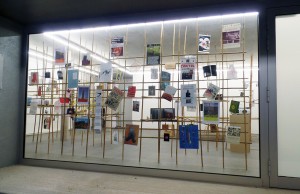
Imaginary Archive/Zeppelin University Edition, September 12th to November 26th, 2015, “Documents from a past whose future never arrived…” White Box, Friedrichshafen, Germany
Imagine yourself uncovering a cache of materials and documents that record a past whose future never arrived? Imaginary Archive is just such a repository: pamphlets, books, photo-albums, records, blueprints, small objects, whose assorted narratives imagine alternative histories and speculative tomorrows that nevertheless frequently shed a precise light on concrete realities. New York based artist Gregory Sholette has invited participants from Germany, Philadelphia, Ukraine, Ireland, New Zealand, Austria as well as others from around the globe to produce this Imaginary Archive, which is a collection of unknown, under-represented, dreaded and/or hoped-for “historical” materials that point to multiple interpretations of the past, the present, and the future. Working with Sholette, architect Marcel Kalberer designed and constructed a bamboo labyrinth within Zeppelin University’s White Box exhibition space to house this most current edition of Imaginary Archive while simultaneously inaugurating this new cultural venue for students and the public. Read more…
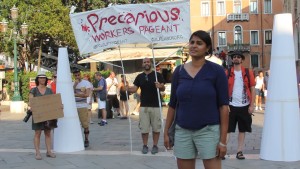 Public Conversation: November 19th, 2015 6:30pm “Gulf Labor and Precarious Workers Rights” The Skylight Room 9100, CUNY, The Graduate Center
Public Conversation: November 19th, 2015 6:30pm “Gulf Labor and Precarious Workers Rights” The Skylight Room 9100, CUNY, The Graduate Center
What does Bertolt Brecht have to do with workers’ rights in Abu Dhabi? Although politically engaged art and theater takes many forms, the recent Precarious Workers Pageant at the Venice Biennale took a Brechtian approach as it pointed out the solidification of global capital in architecture in Abu Dhabi and the precarious state of migrant workers who are building these future cultural sites. The pageant’s street performance offered a new public commons fabricated out of the deconstructed architecture of the avant-garde museum. Join artists, scholars, and activists in conversation for an evening of discussion, debate, and for an evening of discussion, debate, and propositions as part of the Social Choreography seminar at the Center for the Humanities and in tandem with the exhibition by Zoe Beloff at the James Gallery, “A World Redrawn: Eisenstein and Brecht in Hollywood.” Following the Precarious Workers Pageant video premier will be another New York premier: a presentation of The Gulf: High Culture/Hard Labor, edited by A. Ross and published by OR Books, with contributions by Sholette and other members of Gulf Labor. Read more…
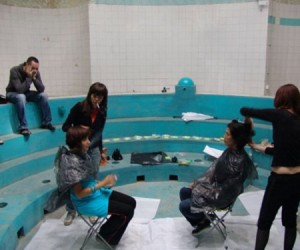 Transversal Methodologies, November 18th, 2015 6:30pm, public lecture, C 19, CUNY, The Graduate Center
Transversal Methodologies, November 18th, 2015 6:30pm, public lecture, C 19, CUNY, The Graduate Center
How do existing methodological structures choreograph the diverse outputs of social art practice and what tools have we developed to enact new transversal methods for instituting this practice? Furthermore, how can social art practice begin to be historicized as it interacts with disciplines of visual art, performance, and theater as well as uneven geographies and political conditions? Join in conversation with sociologist Pelin Tan as she presents her research in this area in conversation with James Gallery curator Katherine Carl and participants in the Social Choreography Working Group. Read more…
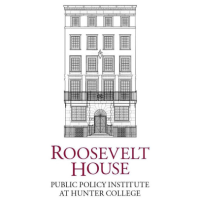 Tania Bruguera in Conversation with Paul Ramirez Jonas, October 9, 2015, Hunter College
Tania Bruguera in Conversation with Paul Ramirez Jonas, October 9, 2015, Hunter College
From Havana to Beijing, authoritarian governments continue to crack down on artists whose work sheds light on the social, political, and economic struggles faced by local populations. Yet despite increasing censorship and persecution, artists continue to engage with and shape political consciousness, both at home and abroad. These topics and more were discussed in a public conversation between Tania Bruguera, a Cuban artist, who was arrested in Havana last year after staging a provocative open-mike performance and Paul Ramirez Jonas, a New York City-based artist whose work challenges the boundaries between artwork and spectator, on the role artists can play in creating social, political, and cultural change. Each semester, the Roosevelt House Public Policy Institute at Hunter College spotlights a prominent public issue with events running through the term. This fall, the focus falls on Politics, Policy and the Arts, with a series of special events co-sponsored by Hunter’s Arts Across the Curriculum program. Read more…
An Evening with Gulf Labor, October 2, 2015, The New School
In 2009, Human Rights Watch published a report, detailing alarming labor conditions and human rights violations on Saadiyat Island in Abu Dhabi where a new Guggenheim Museum was to be built, one of several international cultural institutions. In response, several dozen artists, curators and cultural producers launched the Gulf Labor Artist Coalition with the intention of protect the rights of the migrant workers during the construction of museums on Saadiyat Island. Among various initiatives – public programs, exhibitions such as participation in this year’s Venice Biennale, the artist platform 52 Weeks, and research trips to the Emirates but also the countries where some of the workers come from – most recently, Gulf Labor’s protest has taken the form of a publication, The Gulf: High Culture/Hard Labor. Gulf Labor members Nitasha Dhillon, Mariam Ghani, Amin Husain, Andrew Ross and Gregory Sholette discuss their book and expand on the most recent research and its implication for the work of artists and cultural producers everywhere. Read more…
Art Production in Restriction, Possibilities of Transformative Art Production and Coalitions Seminar: LevArt, September 4th – 7th, Levanger/Trondheim, Norway
Since the neoliberal attack on public institutions of art and art education, artistic work has become an entrepreneurial activity within a restrictive framework conditioned by the expanding art market and hegemonic political agendas prescribing the usefulness of art. The division of labor in the creative and knowledge industries has formed huge masses of artists that serve as a “reserve army” for cheap creative labor. In recent years artists have organized themselves in new ways, developing strategies to agitate for better labor conditions and certain standards of payment for artistic work. Can the general precarity of art production be seen to function as a common denominator in artists’ struggles for better working conditions? Or, do we need a different political basis for coalition-building that would be realized in a different model of production? How can this different production model support coalition-building? In such a setting, can the autonomy of artistic production become an emancipatory force, or should artists join social movements and political parties of the new left that aim for non-capitalist transformation? Read more…
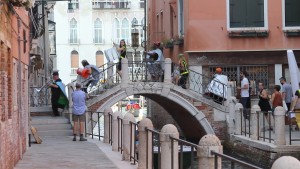 Precarious Workers Pageant at Venice Biennale, 6pm August 7th, S.a.L.E. docks, Venice, Italy
Precarious Workers Pageant at Venice Biennale, 6pm August 7th, S.a.L.E. docks, Venice, Italy
A collaborative project involving members of the: Workers Art Coalition, Aaron Burr Society, Occupy Museums, G.U.L.F., and Social Practice Queens. In order to draw attention to the rights of the workers building the Guggenheim’s Abu Dhabi museum, the Precarious Workers Pageant staged an event in the same city as the site of another Guggenheim during the Venice Biennale. It all begin with a deconstruction of a model of Frank Gehry’s proposed Guggenheim Museum in Abu Dhabi. The liberated shapes from the monument were then carried in a cacophonous procession through nearby streets and over canals, passing by the Peggy Guggenheim Museum to the Galleria dell’Accademia plaza where the emancipated geometric forms were reconstructed into a public commons. This set the stage for a series of testimonials and performances addressing the struggle for social justice amongst migrant workers in the United Arab Emirates, as well as in Europe and the USA. Read Gregory Sholette’s description of the event here, or read the press coverage here.
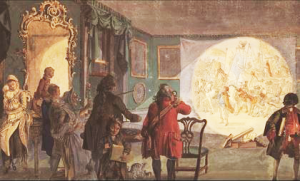 Public Conversation: March 5th, 2015 6:30pm, The Skylight Room, “Red Kant: Michael Wayne, Stephen Wright and Gregory Sholette in Conversation”
Public Conversation: March 5th, 2015 6:30pm, The Skylight Room, “Red Kant: Michael Wayne, Stephen Wright and Gregory Sholette in Conversation”
Immanuel Kant’s strict distinctions between beauty and purpose of objects have undergone many heated discussions in 20th-century art. It is time to reassess his delineations and consider anew their applications to contemporary culture. For instance, how can the connections between Kant and important Marxist concepts such as totality, dialectics, mediation and production be traced and discussed in relation to contemporary art, digital technology, and social art practices that are continually interested in immersive methods and experiences? Join writer and theorist Stephen Wright, author of Toward a Lexicon of Usership, and Michael Wayne, author of Red Kant: Aesthetics, Marxism, and the Third Critique, in a conversation with artist and writer Gregory Sholette about art, aesthetics and politics.
FACULTY Co-leaders
Gregory Sholette is an artist and writer whose publications include It’s The Political Economy, Stupid co-edited with Oliver Ressler, Dark Matter: Art and Politics in an Age of Enterprise Culture, both Pluto Press UK, as well as Collectivism After Modernism with Blake Stimson University of Minnesota Press, and The Interventionists with Nato Thompson distributed by MIT. His recent art projects include Collectibles, Action Figures and Objects, at Station Independent Gallery, Imaginary Archive: Graz, Rotor Art Center, Graz, Austria; NY; Exposed Pipe at the American University Beirut art gallery; Torrent for Printed Matter Books in Chelsea; iDrone for cyberartspace.net; and Fifteen Islands for Robert Moses at the Queens Museum. Sholette is an Associate of the Art, Design and the Public Domain program at the Graduate School of Design Harvard University, a member of the Curriculum Committee of Home WorkSpace Beirut, and a faculty member of the Queens College Art Department, City University of New York where he helped establish the new MFA Concentration SPQ (Social Practice Queens)
Paul Ramirez Jonas is Professor in the MFA program at Hunter College, CUNY. His honors include grants from the National Endowment for the Arts, the Joan Mitchell Foundation, ArtMatters, the Howard Foundation, the International Studio Program in Sweden, and the Atlantic Center for the Arts, among others. Ramírez Jonas’ selected solo exhibitions include the Aldrich Contemporary Art Museum, Ridgefield, CT; the Jack S. Blanton Museum of Art, Austin, TX; Ikon Gallery, Birmingham, UK; Cornerhouse, Manchester, UK; Alexander Gray Gallery, New York; Roger Björkholmen, Stockholm, Sweden; and Postmasters Gallery, New York. He has been included in group exhibitions at the Gallery for Contemporary Art Leipzig, Germany; P.S.1, New York; Whitechapel Gallery, London; Irish Museum of Modern Art, Dublin; Künstlerhaus, Vienna, Austria; The New Museum, New York; and Kunsthaus Zurich, Switzerland. He has participated in the Johannesburg Biennale; the Seoul Biennial, the Shanghai Biennial; the 28th Sao Paulo Biennial; and the 53rd Venice Biennial. He has built permanent projects in Cambridge, MA and a permanent public sculpture for the Hudson River Park, New York City. In 2010, Creative Time presented his “Key to the City” project in New York City.
WORKING GROUP
The Social Choreography working group is dedicated to examining how systems of discipline, desire, power, and sociality choreograph movements, patterns, and gestures in lived experience. With concerns ranging from urban design to dance, Social Choreography seeks to understand how movement is conditioned by larger cultural infrastructures and how it responds to and impacts these infrastructures in antagonistic or reflexive ways. Seminar discussions and research may engage activist-oriented artistic interventions, the structuring of public movement and the circulation of bodies, theories of theater and performance, ethnographic understandings of everyday rhythms and habits, and institutions of control and holding including incarceration, housing, education, and labor management. What are the forms that push back on these aggressions? What is the role of aesthetics as it intersects with politics and the social order? Of concern to our research workshops are recent events of police violence, gentrification, as well as migration due to political conflict and climate change. We hope to engage these matters from as broad a disciplinary base as possible. The working group consists of presentations of participants’ research at any stage of completion and will adopt the format of the studio “crit” during meetings. Though the working group is primarily targeted at graduate students in all fields, faculty are invited and guest speakers will engage discussion periodically. At the end of the fall term, participants will cooperatively determine how to frame or present their research, whether in a multi-author publication, public programming, or the continuation of sessions. Given the focus on presentations and active conversation, the working group will be closed in the fall semester. The Social Choreography Working Group is organized by Joseph Henry and Kaegan Sparks, Ph.D. Program in Art History, and Katherine Carl, The Graduate Center, CUNY.
Members of the Social Choreography Working Group can access more information here.
Community Partners
Aaron Burr Society BRIC Deborah Fisher, A Blade of Grass Gulf Labor Coalition Occupy Museums Social Practice Queens Workers Art Coalition
Projects
The Worker’s Ballet
Performed in public space the Worker’s Ballet will involve a diverse group of men and women garbed in uniforms worn by migrant laborers in the UAE and here in the USA. With a musical score echoing avant-garde compositions from the early 20th Century a crowd of choreographed participants will convene and proceed to unfold compressed 3D graphic props representing details of the signature architecture associated with compromised work sites both New York and the Gulf. Throughout the performance movement will stop long enough for individuals to vociferate prepared testimonials about working conditions based either on their own experience or on direct research carried out with various workers. (* Note: Gulf Labor Coalition has received separate funding to carry out such research in India and the UAE.) The culminating moment of the entire piece will be a sudden act of “coming together” where the various architectural elements based on the works of Frank Gehry and Zaha Hadid among others converges and transforms into a coherent arrangement of collective barricades and shelters as if a temporary utopian workers village was being invented right there in the middle of Manhattan’s “Museum Mile.” The entire performance will be documented for transmission over social media.
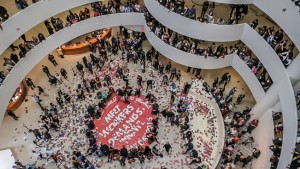
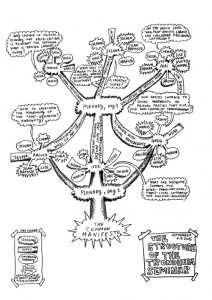
Comments by srowen